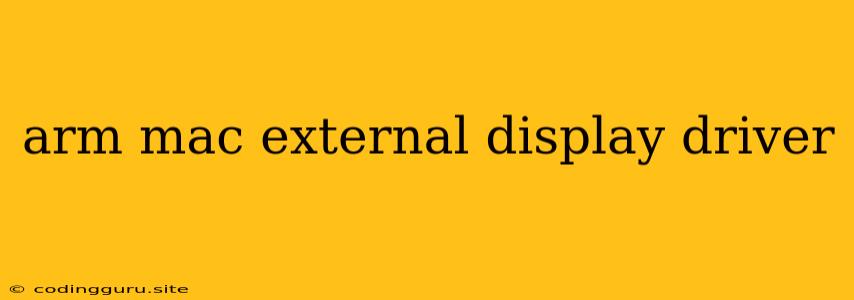Unlocking the Power of External Displays on Your M1 Mac
Owning an M1 Mac with its powerful Apple Silicon chip opens up a world of possibilities. But what if you need more screen real estate? What if you want to enjoy the benefits of a larger display for work, creativity, or entertainment? That's where external displays come in.
However, the M1 Mac's architecture presents a unique challenge for external display drivers, as they need to be specifically designed for the ARM-based processor. Let's dive into the specifics of external display drivers for your M1 Mac and how to ensure a seamless experience.
Why do I Need an External Display Driver?
Think of external display drivers as the bridge between your Mac's graphics system and your monitor. They translate the signals that your computer generates into something the display can understand. Without the right driver, your monitor might only display a blank screen, or you might experience problems with color accuracy, resolution, or refresh rate.
Do I Need a Specific Driver for My M1 Mac?
Yes! The Apple Silicon chip found in M1 Macs uses a different architecture than the Intel processors found in older Macs. Therefore, you need drivers designed specifically for ARM Macs to ensure your external display works correctly.
What if My Display Came with a Driver Disc?
Don't worry if you have an older monitor with a driver disc. In most cases, you'll likely find that the latest macOS update already includes drivers for your display. macOS has a built-in driver library that updates automatically for a wide range of devices.
How to Ensure Your External Display Works Perfectly
- Check for macOS Updates: First and foremost, make sure you have the latest macOS update installed. New updates often include driver updates for external displays.
- Connect Your Display: Connect your external display to your M1 Mac using the appropriate cable (HDMI, DisplayPort, Thunderbolt, etc.).
- Automatic Driver Installation: macOS should automatically detect your display and install the necessary driver if it's available.
- Check Display Settings: Go to "System Preferences" -> "Displays" to adjust the display resolution, color profile, and other settings.
- Troubleshoot If Necessary: If your external display still doesn't work, try the following:
- Restart Your Mac: A simple restart often fixes minor driver issues.
- Check for Updates: Some manufacturers release driver updates for their monitors on their websites.
- Contact Support: If all else fails, reach out to the manufacturer of your external display or Apple Support for assistance.
Tips for a Smooth External Display Experience
- Check Compatibility: Before purchasing a new external display, ensure it's compatible with M1 Macs. You can usually find this information on the manufacturer's website or product page.
- Choose the Right Cable: Use a high-quality cable that supports the resolution and refresh rate you need.
- Thunderbolt for Maximum Bandwidth: If possible, use a Thunderbolt connection for the best performance and capabilities.
- Consider Resolution and Refresh Rate: Higher resolutions and refresh rates can improve your overall user experience, but they also require more processing power. Make sure your M1 Mac can handle the demands of your chosen display.
Additional Considerations
- Display Port vs. HDMI: DisplayPort typically offers better performance and features for external displays compared to HDMI.
- Multi-Display Setup: You can connect multiple external displays to your M1 Mac, but the number and types of displays you can use will depend on your model and the ports available.
Conclusion
Using external displays with your M1 Mac can be a great way to enhance your productivity and enjoyment. By understanding the importance of ARM-specific drivers and following the tips outlined above, you can ensure a seamless and efficient experience with your chosen external display. Remember to keep your Mac updated, check for driver updates, and choose the right display and cables to maximize your setup.
